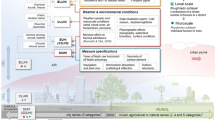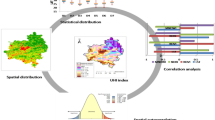Abstract
The dynamic of consolidation of urban areas in Latin America has allowed that almost 80% of the population concentrates in cities; this has produced changes in land covers and modified regional climate, propitiating the appearance of urban heat islands. The Metropolitan Area of Toluca, State of Mexico, Mexico, holds the fifth national place in population size and experiences this process, because of this, the objective is to analyze and compare the spatiotemporal characteristics of the atmospheric urban heat island obtained from data gathered from 12 urban and rural weather stations with the surface urban heat island obtained from the digital processing of four Landsat 8 images. Results show the year-round presence of night-time atmospheric urban heat islands, which reach a peak in autumn (up to 6 °C). Daytime atmospheric urban heat islands occur in summer and autumn with a maximum intensity of 4 °C. For their part, surface urban heat islands occur in spring, summer and autumn and reach maximums of 19 °C in intensity. A strong correlation was found between wetness and surface temperature (coefficient of determination, 0.8) in spring and winter. Soil wetness directly impacts the formation of weak urban heat islands in dry season, and intense ones in wet season, while the green areas and the winds affect the spatial distribution of the same.









Similar content being viewed by others
References
Alonso MS, Labajo JL, Fidalgo MR (2003) Characteristics of the urban heat island in the city of Salamanca (Spain). Atmósfera 16(3):137–148
Anderson S (2002) An evaluation of spatial interpolation methods on air temperature in Phoenix, AZ. Department of Geography, Arizona State University. http://www.cobblestoneconcepts.com/ucgis2summer/anderson/anderson.htm Accessed 21 Oct 2015
Arnfield AJ (2003) Two decades of urban climate research: a review of turbulence, exchanges of energy and water, and the urban heat island. Int J Climatol 23(1):1–26. doi:10.1002/joc.859
Ballinas M, Barradas V (2014) The actual urban heat island in Mexico City. http://www.researchgate.net/profile/Victor_Barradas3/publication/270050061_The_actual_urban_heat_island_in_Mexico_City/links/549ef0870cf267bdb8fdb96e.pdf. Accessed 12 Feb 2015
Ballinas M, Barradas V (2016) The urban tree as a tool to mitigate the urban heat island in Mexico city: a simple phenomenological model. J Environ Qual 45:157–166. doi:10.2134/jeq2015.01.0056
Barradas V (2013) La isla de calor urbana y la vegetación arbórea. http://web.ecologia.unam.mx/oikos3.0/index.php/oikos-historico/numeros-anteriores/47-la-isla-de-calor-urbana-y-la-vegetacion-arborea. Accessed 18 Aug 2016
Capelli de Steffens A, Píccolo M, Hernández J, Navarrete G (2001) La isla de calor estival en Temuco, Chile. Papeles de Geografía 33:49–60
Chuvieco E (2002) Teledetección ambiental, la observación de la tierra desde el espacio. Ariel, Barcelona
Colunga ML, Cabromón-Sandoval V, Suzán-Azpiri H, Guevara-Escobar A, Luna-Soria H (2015) The role of urban vegetation in temperature and heat island effects in Querétaro city, Mexico. Atmósfera 28(3):205–218
EPA (2013) Heat island effect—basic information. www.epa.gov
Fernández F (1995) Manual de climatología aplicada: clima, medio ambiente y planificación. Síntesis, Madrid
Fernández F, Martilli A (2012) El clima urbano: aspectos generales y su aplicación en el área de Madrid. Indice 50:21–24
García M (2013) Clima urbano costero de Mar del Plata y Necochea-Quequén. GAEA, Buenos Aires
García-Cueto O, Jáuregui-Ostos E, Toudert D, Tejeda-Martínez A (2007) Detection of the urban heat island in Mexicali, B.C., México and its relationship with land use. Atmósfera 20(2):111–131
Gedzelman S, Austin S, Cermak R, Stefano N, Partridge S, Quesenberry S, Robinson D (2003) Mesoscale aspects of the urban heat island around New York city. Theor Appl Climatol 75:29. doi:10.1007/s00704-002-0724-2
GEM and COESPO (2012) Zona Metropolitana de Valle de Toluca. Aspectos sociodemográficos. Gobierno del Estado de México, Estado de México
Gillespie AR (1985) Lithologic mapping of silicate rocks using TIMS. In: Proceedings of the thermal infrared multispectral scanner. TIMS data user’s workshop, Jet Propulsion Laboratory, Pasadena, pp 29–44
Gioia A, Paolini L, Malizia A, Oltra-Carrió R, Sobrino JA (2014) Size matters: vegetation patch size and surface temperature relationship in foothills cities of northwestern Argentina. Urban Ecosyst 17(4):1161–1174. doi:10.1007/s11252-014-0372-1
Jauregui E (1997) Heat island development in Mexico city. Atmos Environ 31(22):3821–3831. doi:10.1016/S1352-2310(97)00136-2
Jauregui E (2005) Possible impact of urbanization on the thermal climate of some large cities in México. Atmósfera 18(4):249–252
Jauregui E, Godinez L, Cruz F (1992) Aspects of heat-island development in Guadalajara, Mexico. Atmos Environ Urban Atmos 26B(3):391–396. doi:10.1016/0957-1272(92)90014-J
Jiménez-Muñoz JC, Sobrino JA, Gillespie A, Sabol D (2003) Separación emisividad/temperatura a partir de datos DAIS y aplicación del contraste espectral para discriminar distintos tipos de vegetación. Revista de Teledetección 19:51–58
Jiménez-Muñoz JC, Sobrino JA, Cristóbal J, Sòria G, Ninyerola M, Pons X, Hidalgo V, Franch B, Romaguera M, Oltra-Carrió R, Julien Y, Mattar C (2010) Obtención de la temperatura de la superficie terrestre a partir de la serie histórica LANDSAT. Revista de Teledetección 33:53–63
Li C-f, Shen D, Dong J-s, Yin J-y, Zhao J-j, Xue D (2014) Monitoring of urban heat island in Shanghai, China, from 1981 to 2010 with satellite data. Arab J Geosci 7:3961–3971. doi:10.1007/s12517-013-1053-8
López A, Fernández F, Arroyo F, Martín J, Cuadrat JM (1993) El clima de las ciudades españolas. Cátedra. Madrid
Montávez J, Rodríguez A, Jiménez J (2000) A study of the urban heat island of Granada. Int J Climatol 20:899–911. doi:10.1002/1097-0088(20000630)20:8<899::AID-JOC433>3.0.CO;2-I
Morales C, González L, Madrigal D (2007) Isla de calor en Toluca, México. Ciencia Ergo Sum 14(3):307–316
Nichol J, Yee Fung W, Lam K, Wong S (2009) Urban heat island diagnosis using ASTER satellite images and ‘in situ’ air temperatura. Atmos Res 94:276–284. doi:10.1016/j.atmosres.2009.06.011
Oke TR (1982) The energetic basis of the urban heat island. Q J R Meteorol Soc 108:1–24. doi:10.1002/qj.49710845502
Oke TR (1987) Boundary layer climates, 2nd edn. Routledge, London
Oke TR, Hannell F (1970) The form of the urban heat island in Hamilton, Canada, en urban climates (vol 108). WMO technical note, pp 113–126
Olalla F, Calera A (2005) Uso de la teledetección en el seguimiento de los cultivos de regadío. En: Agua y agronomía. Mundi Prensa Libros S.A., Madrid
Peña MA (2008) Relationships between remotely sensed surface parameters associated with the urban heat sink formation in Santiago, Chile. Int J Remote Sens 29(15):4385–4404. doi:10.1080/01431160801908137
Peña MA, Romero H (2005) Relación espacial y estadística entre las islas de calor de superficie, coberturas vegetales, reflectividad y contenido de humedad del suelo, en la ciudad de Santiago y su entorno rural. Anales de la Sociedad Chilena de Ciencias Geográficas 2005:107–118
Romero H, Salgado M, Smith P (2010) Cambios climáticos y climas urbanos. Relaciones entre zonas termales y condiciones socioeconómicas de la población de Santiago de Chile. INVI 25(70):151–179
Roy DP, Wulder MA, Loveland TR, Woodcock CE, Allen RG, Anderson MC, Helder D, Irons JR, Johnson DM, Kennedy R, Scambos TA, Schaaf CB, Schott JR, Sheng Y, Vermote EF, Belward AS, Bindschadler R, Cohen WB, Gao F, Hipple JD, Hostert P, Huntington J, Justice CO, Kilic A, Kovalskyy V, Lee ZP, Lymburner L, Masek JG, McCorkel J, Shuai Y, Trezza R, Vogelmann J, Wynne RH, Zhu Z (2014) Landsat-8: science and product vision for terrestrial global change research. Remote Sens Environ 145:154–172. doi:10.1016/j.rse.2014.02.001
Ruiz-Flaño P, Romero L, Máyer P, Hernández A (2008) Las islas de calor en las Palmas de Gran Canaria: intensidad, distribución y factores condicionantes. Boletín de la AGE 47:157–173
Sarricolea P, Martín-Vide J (2013) La isla de calor urbana del área metropolitana de Santiago (AMS) de Chile a partir de diferencias térmicas de los observatorios de Talagante y Cerrillos. Perspectiva Geográfica 18(2):239–256. doi:10.19053/01233769.2677
Sarricolea P, Martín-Vide J (2014) El estudio de la isla de calor urbana de superficie del Área Metropolitana de Santiago de Chile con imágenes Terra-MODIS y análisis de componentes principales. Revista de Geografía Norte Grande 57:123–141. doi:10.4067/S0718-34022014000100009
Sarricolea P, Romero H (2010) Análisis de los factores condicionantes sobre las temperaturas de emisión superficial en el área metropolitana de Valparaíso Chile. ACE 14:79–96
SEDESOL, CONAPO, INEGI (2012) Delimitación de las zonas metropolitanas de México 2010. SEDESOL, CONAPO, INEGI. México
Sobrino J, Oltra-Carrió R, Sòria G, Jiménez-Muñoz J, Franch B, Hidalgo V, Mattar C, Julien Y, Cuenca J, Romaguera M, Gómez J, De Miguel E, Bianchi R, Paganini M (2013) Evaluation of the surface urban heat island effect in the city of Madrid by thermal remote sensing. Int J Remote Sens 34(9–10):3177–3192. doi:10.1080/01431161.2012.716548
UN-HABITAT (2012) Estado de las ciudades de América Latina y El Caribe 2012, rumbo a una nueva transición urbana. UN-HABITAT, Kenia
USGS (2015) Landsat 8 (L8) data user handbook. http://landsat.usgs.gov/documents/Landsat8DataUsersHandbook.pdf. Accessed 18 Sep 2015
van Hove LWA, Jacobs CMJ, Heusinkveld BG, Elbers JA, van Driel BL, Holtslag AAM (2015) Temporal and spatial variability of urban heat island and thermal comfort within the Rotterdam agglomeration. Build Environ 83:91–103. doi:10.1016/j.buildenv.2014.08.029
Vidal J, Jáuregui E (1991) Evolución de la isla de calor en Toluca Mex. observatoriosgeograficoamericalatina.org.mx/egal3/Procesosambientales/Climatología. Accessed 2 Sep 2015
Voogt J (2008) Urban heat islands: hotter cities. http://www.actionbioscience.org/environment/voogt.html. Accessed 21 Apr 2015
Voogt J, Oke TR (2003) Thermal remote sensing of urban climates. Remote Sens Environ 86(3):370–384. doi:10.1016/S0034-4257(03)00079-8
Zhang J, Wang Y (2008) Study of the relationships between the spatial extent of surface urban heat islands and urban characteristic factors based on landsat ETM+ data. Sensors 8:7453–7468. doi:10.3390/s8117453
Zhao L, Lee X, Smith R, Oleson K (2014) Strong contributions of local background climate to urban heat islands. Nature 511(7508):216–219. doi:10.1038/nature13462
Author information
Authors and Affiliations
Corresponding author
Rights and permissions
About this article
Cite this article
Rivera, E., Antonio-Némiga, X., Origel-Gutiérrez, G. et al. Spatiotemporal analysis of the atmospheric and surface urban heat islands of the Metropolitan Area of Toluca, Mexico. Environ Earth Sci 76, 225 (2017). https://doi.org/10.1007/s12665-017-6538-4
Received:
Accepted:
Published:
DOI: https://doi.org/10.1007/s12665-017-6538-4




